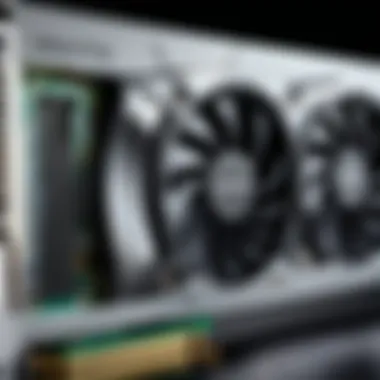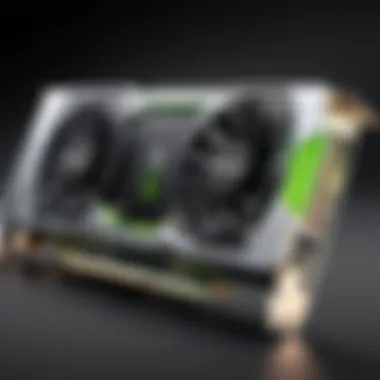Understanding NVIDIA GPU Manufacturers: Overview


Intro
The world of NVIDIA GPU manufacturers is complex and layered. As an essential component in the gaming and professional graphics industry, these manufacturers play a significant role in shaping the performance and capabilities of NVIDIA's graphics processing units (GPUs). It is crucial for IT professionals and tech enthusiasts alike to have a clear understanding of the various manufacturers and their contributions. This overview aims to demystify the landscape, highlighting key players like ASUS, MSI, and Gigabyte while providing insights into how these companies differentiate themselves through their product offerings.
Features Overview
When examining NVIDIA GPU manufacturers, it is essential to consider the features they provide. Each manufacturer brings a unique perspective and approach to the table, affecting performance, durability, and design aesthetics.
Key Specifications
Different manufacturers emphasize different specifications in their NVIDIA GPU offerings. For instance, ASUS often focuses on thermal solutions, deploying advanced cooling technologies such as vapor chamber cooling to maintain optimal temperatures even under heavy loads.
MSI, on the other hand, emphasizes performance by integrating factory overclocks, which can yield significant advantages in demanding applications. Gigabyte distinguishes itself with its Windforce technology that intelligently balances cooling effectiveness and noise levels, delivering a more pleasant user experience.
Some common specifications to consider include:
- CUDA Cores: More cores generally result in better performance in parallel processing tasks.
- Memory Size: The amount of VRAM can affect gaming performance, especially at higher resolutions.
- Cooling Solutions: Different cooling systems can impact thermal throttling and overall reliability.
Unique Selling Points
Every manufacturer has unique selling points that may appeal to different user segments.
- ASUS: Known for its ROG (Republic of Gamers) line, ASUS combines gaming-oriented aesthetics with high-performance thermal management.
- MSI: Their Afterburner software provides extensive overclocking options, appealing to power users and gamers who want to get every ounce of performance.
- Gigabyte: With a strong emphasis on build quality, they often utilize durable components and robust power delivery systems to ensure longevity.
Performance Analysis
Analyzing the performance of NVIDIA GPUs from different manufacturers can provide valuable insights into which option is best for specific use cases.
Benchmarking Results
Benchmarking is a crucial step in evaluating GPU performance. Different review websites benchmark GPUs under various conditions, revealing how they perform in real-world applications.
- For instance, when running demanding games such as Cyberpunk 2077 or Forza Horizon 5, the performance might vary based on the cooling efficiency and factory clock speeds provided by each manufacturer.
- Results typically indicate that ASUS models may excel in sustained workloads due to superior cooling, while MSI GPUs might shine in short bursts due to aggressive overclocking.
Real-world Scenarios
Understanding performance in everyday scenarios is as important as raw benchmarking. In gaming, for example, a user might find that the differences in frame rates between models become negligible in practical applications. However, if they are working with applications such as Blender or AutoCAD, the discrepancies might become more pronounced.
"The essence of choosing a GPU goes beyond technical specifications; it encompasses the performance in your typical use case."
Prologue to NVIDIA GPUs
NVIDIA GPUs hold a pivotal position in the realm of computing, especially regarding graphics performance and processing power. Their capabilities extend beyond mere gaming, touching diverse industries ranging from professional design to machine learning and AI-driven applications. This extensive utility demonstrates the relevance of understanding the underlying manufacturers that produce these essential components.
An important aspect of the NVIDIA GPU landscape is how manufacturers influence the performance and quality of the final product. Each manufacturer tailors their versions of NVIDIA’s technologies to meet specific needs and requests from consumers. This customization leads to a variety of choices that cater to different segments of the market.
Understanding the characteristics of NVIDIA GPUs involves looking at the strengths and innovations that various companies bring to the table. A comprehensive understanding enables IT professionals and tech enthusiasts to make informed decisions when it comes to selecting the right GPU for their tasks. It can be a daunting task to sift through the technical specifications and performance metrics, which is why this exploration serves as a critical resource for those invested in technology.


Significance in the Technology Landscape
The significance of NVIDIA GPUs in the overarching technology landscape can not be overstated. They effectively blend hardware capabilities with software optimizations to ensure optimal performance across a multitude of applications. Industries that rely heavily on visual computing, such as gaming, film, and architecture, have been transformed by these powerful devices. The importance of high-performance GPUs becomes evident when one considers the demand for better rendering, accelerated computations, and seamless graphics across platforms.
Moreover, the growing need for data processing in AI and machine learning applications has further showcased NVIDIA's role as a leader in GPU technology. Their innovations in parallel processing capabilities enable efficient handling of extensive datasets, making them essential tools for researchers and developers.
Role of Manufacturers in GPU Development
Manufacturers are a fundamental pillar in the development of NVIDIA GPUs. Each company possesses unique strengths that contribute to the product offering. Some manufacturers excel in design, while others focus on cooling systems or overclocking capabilities. As a result, GPUs from different manufacturers often feature specific designs or improvements that can affect their performance.
The relationship between NVIDIA and its partners fosters competition. This competition drives innovations that continuously enhance the GPU performance landscape. Over time, manufacturers have introduced custom cooling solutions, improved power phases and stable overclocks to optimize user experience. Such differentiation allows consumers to choose based on specific needs, whether they prioritize gaming, professional applications, or compact form factors.
As the GPU market continues to evolve, the role of manufacturers remains critical. They not only produce the hardware but also shape the ecosystem through support, warranties, and customer service. Understanding these roles enables consumers to select a GPU that not only meets technical specifications but also aligns with their own preferences and needs.
Key Players in the NVIDIA GPU Market
The landscape of NVIDIA GPU manufacturing is complex, shaped by several key players who contribute to the overall market dynamics. Understanding these players offers valuable insights into how product innovation occurs, market strategies are formulated, and ultimately how consumers make their purchasing decisions. Each manufacturer presents unique offerings that cater to different segments of the market, affecting everything from price points to performance features. This section will explore both established companies and newcomers, highlighting their impact on the industry.
Overview of Major Manufacturers
When considering the major manufacturers of NVIDIA GPUs, ASUS, MSI, Gigabyte, and EVGA frequently emerge as prominent names. Here are some of their distinct attributes:
- ASUS is known for its strong emphasis on innovation and performance. Their products often integrate advanced cooling solutions and robust build quality, making them popular among gamers and enthusiasts.
- MSI tends to focus on gaming performance, emphasizing superior thermal design. This strong focus on user experience has led to many favorable reviews within the gaming community.
- Gigabyte strikes a balance between quality and affordability, appealing to both budget-conscious consumers and those seeking high-performance options. Their GPUs are recognized for reliable performance across various applications.
- EVGA prioritizes community engagement and customer support. This has cultivated a loyal customer base that appreciates post-purchase assistance and product reliability, especially in high-performance settings.
These companies not only provide hardware but also influence trends in gaming, digital content creation, and AI processing. Understanding their unique contributions is vital for making informed decisions.
Emerging Manufacturers and Startups
The GPU market is also becoming populated with new players and startups that bring fresh ideas and innovations. Companies like ZOTAC, PNY, and Inno3D have started to carve out their niche in this competitive environment.
- ZOTAC specializes in compact solutions designed for versatile use, appealing to those who require space-efficient designs without sacrificing performance.
- PNY targets both the professional and consumer segments, providing products tailored to a range of needs, from gaming to workstation applications.
- Inno3D offers niche products and custom designs, often focusing on unique demands in specific markets such as cryptocurrency mining.
These emerging manufacturers contribute to diversifying the choices available, fostering innovation, and pushing established companies to improve their offerings. Understanding their role is significant for both consumers and industry observers, as the landscape continues to evolve.
Detailed Profiles of Leading NVIDIA GPU Manufacturers
The section on detailed profiles of leading NVIDIA GPU manufacturers is crucial for understanding the competitive terrain in the graphics hardware market. Each manufacturer has its unique strengths that cater to both enthusiasts and professionals. By examining each company closely, one can discern how their innovations and strategies impact consumer choice. This analysis not only helps potential buyers make informed decisions but also highlights the evolution of technologies influencing the GPU landscape.
ASUS: Innovation and Performance
ASUS stands out in the GPU market due to its commitment to innovation. The company consistently integrates cutting-edge technology into its graphics cards. For example, the ROG Strix series offers advanced cooling solutions and customizable RGB lighting, appealing to gamers. ASUS prioritizes performance across all its products, ensuring that every GPU meets rigorous testing standards. This reliability is essential for users engaging in high-end gaming or professional graphic design applications.
MSI: Gaming Focus and Thermal Design
MSI has carved a niche for itself as a leader in gaming-oriented GPUs. Their Gaming X and Ventus series are designed with gamers in mind. These GPUs boast impressive thermal management systems, including the Freezer and Torx fan technologies. Thermal performance is a key consideration, as it directly influences a card’s longevity and efficiency. By keeping temperatures down, MSI’s GPUs can maintain high levels of performance without throttling. This focus on gaming and cooling solutions positions MSI favorably among avid gamers.
Gigabyte: Balancing Quality and Affordability


Gigabyte approaches the GPU market with an emphasis on balancing quality with affordability. Their AORUS series has gained recognition for providing high-quality performance at a reasonable price. Gigabyte carefully selects materials and applies effective manufacturing processes that ensure durability without sacrificing performance. This balance makes their products attractive to budget-conscious consumers who seek reliable GPU solutions without excessive costs.
EVGA: Community and Support Emphasis
EVGA distinguishes itself in the market through its focus on community engagement and customer support. The company has built a strong rapport with its user base, often listening to feedback and implementing suggestions in future products. Their products, such as the FTW series, are highly regarded not only for performance but also for the extensive support EVGA provides. This includes warranties, easy returns, and online forums for users. EVGA’s commitment to community strengthens consumer loyalty and trust.
ZOTAC: Compact Solutions for Versatile Use
ZOTAC caters to a specific segment of the market with its compact GPU design strategies. Their mini-series graphics cards are ideal for small form factor PCs, making gaming and graphics processing accessible to users with limited space. ZOTAC manages to pack high performance into smaller configurations without causing heating issues. This versatility attracts gamers who enjoy customization and those looking for powerful hardware that fits in tight spaces.
PNY: Professional and Consumer Segment Focus
PNY specializes in targeting both professional users and general consumers. Their Quadro line of graphics cards serves professionals in fields such as CAD, video editing, and 3D modeling. At the same time, PNY offers consumer-level cards that enable solid gaming experiences. This dual focus allows PNY to appeal to a broad audience while ensuring they meet the specific demands of different types of users.
Inno3D: Niche Products and Custom Designs
Inno3D specializes in niche products and custom designs. The company often collaborates with other brands to release unique solutions, such as specialized cooling systems and aesthetically distinctive models. Their dedication to customization allows them to cater to discerning users who seek GPUs that not only perform well but also stand out visually in their setups. This approach enhances Inno3D's appeal in a crowded market, as bespoke solutions become increasingly important demand for tech enthusiasts.
Key Considerations in Choosing NVIDIA GPUs
When selecting an NVIDIA GPU, several critical factors come into play. Understanding these considerations helps in making an informed decision. The right GPU can significantly enhance system performance, especially for tasks like gaming, rendering, or machine learning. Key points to consider include performance metrics, thermal management, and warranty factors.
Performance Metrics to Evaluate
Performance is the cornerstone when choosing a GPU. The metrics vary based on the intended use. For gaming, one must consider frames per second (FPS), resolution, and graphical settings. A higher FPS leads to smoother gameplay. Moreover, benchmarks from sources like TechSpot or Tom's Hardware can provide comparative insights across models.
Different NVIDIA GPUs may also have varying amounts of memory, often referred to as VRAM. For instance, a 6GB VRAM is more suited for 1080p gaming whereas 8GB or higher is ideal for 1440p or 4K gaming. Thus, evaluating benchmarks against these metrics is crucial for optimizing user experience in gaming.
Thermal Management and Cooling Solutions
Thermal management stands out as a significant factor that affects a GPU’s longevity and performance. As GPUs undertake heavy tasks, they generate heat. An effective thermal solution retains optimal performance by dissipating heat efficiently. Several manufacturers implement unique cooling solutions.
For example, ASUS may use advanced cooling fans, whereas MSI might rely on heated pipes coupled with innovative fan designs. Choosing a GPU with proven cooling technology can prevent throttling, ensuring performance under demand. A chassis with ample airflow can also contribute positively. It is essential to consider compatibility with existing systems, especially in compact builds.
Warranty and Customer Support Factors
Warranty plays an integral role in the purchasing decision for NVIDIA GPUs. A solid warranty indicates the manufacturer's confidence in their product. Customers should look for coverage details, duration, and what it specifically entails. Some brands like EVGA are known for robust customer support and extended warranties, reflecting commitment to users.
Additionally, understanding the chain of service for repairs and replacements can save time and cost in the long run. Checking customer feedback on support experiences through forums such as Reddit or review sites may provide useful insights to gauge reliability.
Market Trends in NVIDIA GPU Manufacturing
The landscape of NVIDIA GPU manufacturing is constantly evolving. Understanding the current market trends is vital for IT professionals and tech enthusiasts alike. These trends not only reflect the technological advancements but also the underlying shifts in consumer behaviors and demands. Being aware of these elements helps consumers make informed decisions about their GPU choices, which can significantly impact their overall computing experience.
Technological Advancements
In recent years, technological advancements have reshaped the NVIDIA GPU market dramatically. Key innovations include the introduction of ray tracing and DLSS (Deep Learning Super Sampling) technology. These features have elevated the graphical capabilities of GPUs, offering more realistic lighting and improved frame rates in gaming and professional applications.


Moreover, advancements in manufacturing processes have led to higher performance GPUs that are also more energy-efficient. For instance, the shift from 14nm to 7nm processes indicates a significant leap in density and power efficiency. This helps in cooling solutions as well, allowing for quieter and more effective thermal management in GPU designs.
Another trend is the integration of AI capabilities within GPUs. NVIDIA’s dedicated AI hardware is becoming standard, making these chips more versatile for computational needs beyond gaming, including machine learning and data analysis. Understanding these advancements provides consumers with critical insights into the performance benefits and future-proofing of their GPU selections.
Shifts in Consumer Preferences
The preferences of consumers have seen noticeable changes and reflect a broader trend towards customization and flexibility. Enthusiasts now demand GPUs that not only perform but also fit specific aesthetic preferences and system requirements. Consequently, manufacturers like ASUS and MSI are responding by offering customizable RGB lighting and unique cooling solutions.
Additionally, there is a growing emphasis on the importance of sustainability. Many consumers now prioritize manufacturers who are focused on eco-friendly practices and energy efficiency. This consideration is driving some brands to innovate in packaging and material uses, responding to the trend of conscious consumerism.
Lastly, with the rise of the PC gaming community, the demand for affordable yet high-performance GPUs has surged. Entry-level gamers are looking for budget-friendly options that do not compromise on quality. This has led to manufacturers promoting mid-range products aggressively, ensuring a wider accessibility to advanced gaming technologies.
"Keeping track of these consumer trends not only influences purchasing decisions but also shapes the direction of future product developments in the market."
By recognizing these shifts, consumers can better select their GPUs to meet their current and future needs, while manufacturers can strategically position their products in a competitive market.
Future Outlook for NVIDIA GPU Manufacturers
The future outlook for NVIDIA GPU manufacturers is crucial for understanding both the evolution of graphics technology and the competitive landscape. As the demand for advanced graphical capabilities grows, manufacturers must adapt to new trends and challenges. The importance lies not only in predicting market shifts but also in strategizing responses to growing consumer expectations and advances in technology.
Predictions on Industry Developments
Several trends are poised to shape the future of NVIDIA GPU manufacturing. Key predictions include:
- Increased Integration of AI: The integration of artificial intelligence will continue to transform how GPUs are designed and utilized. Manufacturers may focus on enhancing AI capabilities, which could lead to more efficient processing and improved performance across a range of applications.
- Expansion of Ray Tracing Technology: Ray tracing offers realism in graphics rendering. As this technology becomes more mainstream, manufacturers will likely invest heavily on improving their hardware's ability to handle such processes more efficiently.
- Rise of Cloud Gaming: The trend towards cloud-based gaming is reshaping the market. GPU manufacturers may shift their focus to hardware that optimally supports cloud gaming ecosystems, impacting system designs and product offerings.
- Environmental Concerns: Sustainability will become a key factor in the production of GPUs. Manufacturers will explore eco-friendly materials and energy-efficient designs to cater to a more environmentally conscious consumer base.
"Understanding these predictions allows IT professionals and tech enthusiasts to anticipate shifts in GPU offerings and prepare for future developments in the gaming and professional sectors."
Strategies for Sustained Competition
Moving forward, NVIDIA GPU manufacturers will need comprehensive strategies to maintain competitiveness. Some strategies include:
- Innovation in Design: Continuing to push the limits of design, both in performance and aesthetic appeal, can attract new customers and build brand loyalty.
- Fostering Community Engagement: Many successful manufacturers engage directly with their user communities. This includes gathering feedback on products and addressing concerns quickly, which can enhance brand reputation.
- Flexible Product Lines: Developing a diverse range of products at varying price points will help manufacturers tap into different segments of the market, including entry-level consumers and high-end gamers.
- Collaborations and Partnerships: Forming partnerships with software developers and game studios can enhance product relevance and brand visibility, ensuring that new technologies are leveraged effectively.
Such strategies are essential for the NVIDIA GPU landscape to adapt, grow, and thrive in the face of constant change.
Ending
The conclusion serves as a vital component of understanding NVIDIA GPU manufacturers. It synthesizes the insights accumulated throughout the article and offers clarity on complex choices regarding graphics cards. This section is essential because it allows readers to reflect on key points discussed in the previous sections, ensuring that they grasp the significance of various manufacturers and their products.
Recapping Key Insights
In this article, we explored numerous aspects of NVIDIA GPU manufacturers. Some of the crucial points include:
- Diverse Offerings: Major players like ASUS, MSI, and Gigabyte differ significantly in their product lines and target audiences.
- Performance Metrics: Understanding how to evaluate performance metrics helps in making informed decisions.
- Thermal Management: Effective cooling solutions are crucial for maintaining performance and longevity.
- Community Support: Brands like EVGA emphasize customer support and community engagement, which are essential for tech enthusiasts.
These insights underline the need for IT professionals and tech enthusiasts to conduct thorough research before making GPU selections.
Final Thoughts on GPU Selection
When selecting an NVIDIA GPU, consider the following factors:
- Purpose: Identify what you will primarily use the GPU for, whether gaming, professional work, or casual tasks.
- Performance Needs: Different GPUs cater to varying performance demands. Make sure you understand your requirements.
- Budget: A clearly defined budget helps narrow choices and can impact the decision significantly.
- Brand Reputation: Evaluate brand reliability and customer satisfaction.
In summary, careful consideration and informed choices are paramount in the selection process of NVIDIA GPUs. The future of GPU technology promises continued evolution and innovation, making it essential to stay informed about market developments and product offerings.



